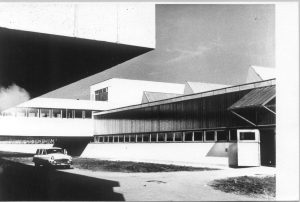Contact Parts Factory
The already nationalized company had already achieved significant results in 1950. It was the only one in the country to produce electrical installation materials for domestic and export. Until 1953, it was engaged in the production of various electrical products. After 1953, it essentially produced various box and device switches, household and industrial plug connectors, and incandescent lamp sockets. From 1959, they began to develop instrument components necessary for the instrument industry. From the 1960s, they began to produce electrical installation materials in earnest in the new factory area.
- István Szalay, company founder
- László Károlyi, manager of the BPR - Business Process Reengineering project from 1993-1997, technical director from 1996, industrial director from 2000, currently CEO (in 2011)
From the 1940s to the 1960s, four-pole industrial blade connectors were manufactured. This was followed by the recessed two-pole socket. From the 1960s, thanks to the large domestic housing construction program, there was a huge demand for electrical installation products. From the 1970s, a two-pole grounded socket and plug family, as well as industrial connection systems, were manufactured.
After 1992, electrical installation items were produced, as well as plastic and metal mass products.
Following the decision of the Economic Committee in 1963, and based on the decision of the Deputy Minister in July 1963, the Kontakta Components Factory was established from the merger of the Watch Factory and the Kontakta Electrical Assembly Products Factory.
In 1968, the company separated the production area operating at the Budapest site from the main management organization and established the Budapest factory unit and its management organization to manage it.
The company was formed into two legal successors on July 1, 1988. In Szentes, Kontakta Villamosszerelési Vállalat (Kontavill), while the Budapest branch of the company ceased to exist in 1989 without a legal successor.
The Szentes factory was transformed into a joint-stock company in 1992 and joined the French Legrand group.
In 2011, Legrand Zrt., formerly known as Kontakta and then Kontavill, celebrated half a century of operation in Hungary.
After the nationalization of 1948, the watch factory was moved to the factory of the former Gira and Becsey company in Pesterzsébet.
In the 1950s, the Watch Factory began to grow rapidly and the production area was expanded several times (nearly nine times compared to the beginning).
Kontakta has also undergone numerous location changes and expansions.
Kontakta moved to Váci Street in 1953.
In 1960, with the help of the city council, the production of electrical installation materials began in Szentes, Csongrád County, on an area of 3,000 m², in the former Zsoldos mill building.
In 1967, a multi-storey building with a floor area of 3,000 m² was built in Budapest to unify the highly fragmented production.
In the 1970s, the galvanizing plant, consisting of program-controlled automatic galvanizing lines, was the most modern plant of its kind in the country. After 1988, Kontavill was the market leader in Hungary, primarily a manufacturer and distributor of fittings.
Created: 2016.07.10. 16:48
Last modified: 2017.05.12. 15:51

